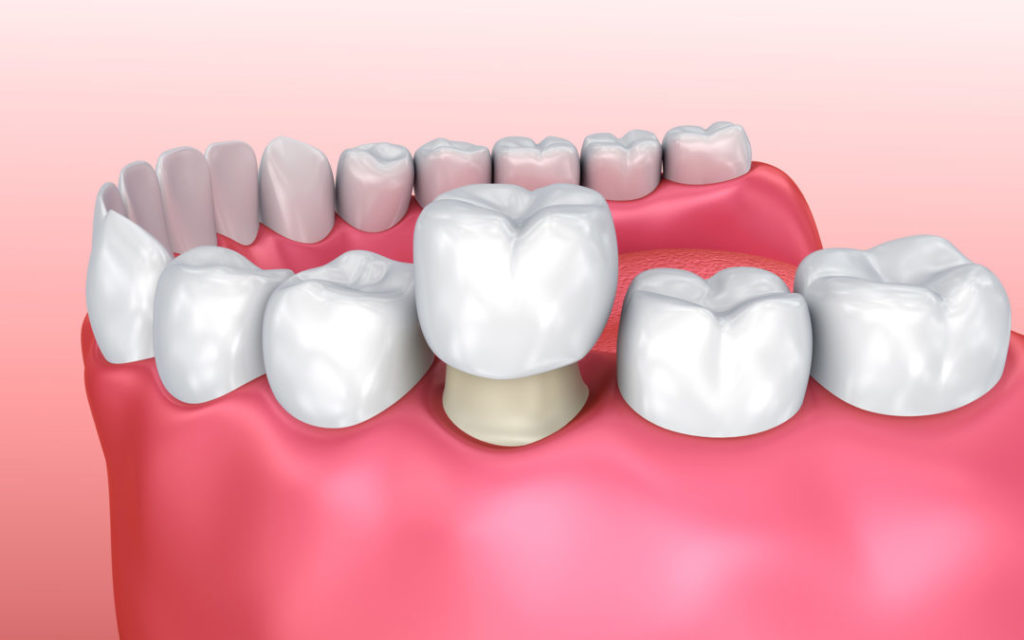Dental Crowns

Have questions about dental crowns and restorative dentistry? Our dentists took some time to share information and answer common patient questions to help educate about what crowns are and the role that they play in oral health. View the table of contents below to learn more or find your question and get an answer from one of our dentists!

The following content was provided by Dr. Don Bailey, DDS, and has been medically reviewed for accuracy. Some relevant links have been added to audio transcripts to provide resources for additional information.
Table of Contents:
Click a question below to be taken directly to that answer.
What are dental crowns?
Answer provided by Dr. Don Bailey. Transcript included below.
Dr. Don Bailey:
Dental crowns are a way of restoring the tooth where instead of just repairing the actual defect where a cavity is or where the tooth is cracked, you’re actually going to restore the entire outer surface of the tooth back to its sort of original high quality strong surface. The outer layer of our tooth is the enamel layer and it works like a crash helmet to absorb impact when we chew. The surface is also shaped a certain way so that our teeth will grind and tear into food against each other.
So whenever you have a cavity and the tooth is then filled afterwards, you’re replacing a portion of your enamel with an artificial material. Whenever the tooth chips or breaks, you’re also doing the same thing. So when you’ve had a significant amount of replacement of the natural enamel with filling material, you don’t really have a tooth that’s very strong anymore. It can break on a hard enough impact. And also too, sometimes when you’re using filling material to try to rebuild a large portion of the tooth, you don’t get the natural contours and shaping that the tooth originally had, which means sometimes it’s more difficult to chew food. Sometimes food can get stuck between the teeth because it’s hard to make the filling materials exactly the right shape.
So when you have enough damage to a tooth where the enamel can no longer protect the tooth or where the tooth has had so many fillings that the tooth no longer functions like it used to, you’re just going to replace the entire outer layer of the tooth with a new restoration. You’re basically replacing the natural crown with an artificial crown.
What are dental crowns made of?
Answer provided by Dr. Don Bailey. Transcript included below.
Dr. Don Bailey:
Crowns have been traditionally made of gold and porcelain or porcelain layered over gold. Gold was the standard for a long time for biting teeth in the back, and porcelain would be used for front teeth. The porcelain is just not very strong. You can’t do a lot of hard functioning on it. Eventually, in the United States, we had the idea that teeth should look like teeth, so we started doing crowns with porcelain layered over gold for back teeth, but you still were dealing with porcelain, which is the weak link in the whole process. So probably about 30 years ago, they began developing harder ceramic type materials or harder porcelain type materials so that we could do crowns that looked natural and were also really strong.
Crowns can be made of hardened glasses or different types of ceramics. The two main types of crowns that are done that are tooth colored and natural looking are made of a hardened ceramic called zirconium dioxide, which is what ceramic cutlery and ball bearing and ceramic gears and high temperature equipment, what they’re made out of. And also a material called lithium disilicate, which is a hardened glass, which is very, very aesthetic, but not quite as strong as the zirconium dioxide.
Are gold dental crowns made of real gold?
Answer provided by Dr. Don Bailey. Transcript included below.
Dr. Don Bailey:
Actually the yellow gold is incredibly expensive. The white gold, it has a lot of platinum and palladium and materials like that in it. It has a silvery, kind of a platinum look. That’s pretty standard material as far as cost goes. But when you go with the yellow gold, the market prices for the metals that are in the yellow gold crowns now are very high. So it’s usually more expensive to do a high content, like 14 carat or higher yellow gold will tend to be several hundred dollars more than any other comparable crown.
Gold is probably the strongest, just because gold can’t break. But gold for most people, gold is something that doesn’t necessarily fit their idea of what their smile should look like, and other people, they enjoy seeing the gold. So for people who don’t want gold, the next strongest material really is the zirconium dioxide. That’s the hardened ceramic.
Both the lithium disilicate glass and the zirconium dioxide ceramic crowns, they are milled out of blocks of material by CAD/CAM milling machine, and then they’re heated at thousands of degrees Fahrenheit sometimes to harden these things. So it’s a really futuristic, scientific process that makes them. They’re getting as strong as gold. They’re close to having the same strength that gold has.
History of dental crowns vs. porcelain veneers
Answer provided by Dr. Don Bailey. Transcript included below.
Dr. Don Bailey:
Traditional porcelain for crowning front teeth was not very strong so you had to take away a lot of your tooth. Whenever we shaped it, we had to take a lot away to make the porcelain crowns thick enough to resist breaking. So a lot of people weren’t really crazy about taking the tooth and grinding so much away when the tooth was overall pretty strong, and they just wanted to do things like cover up an antibiotic stain on a tooth or replace a chip corner on the tooth. A lot of people just didn’t see the point in grinding so much of their tooth away to do that. If you went with the porcelain laid over gold which was stronger, they didn’t really match the other teeth around them because the gold always made them so opaque. If you were using those porcelain fused to gold crowns, you would have to do all of them so that they would match each other. You had a hard time doing just one single tooth.
So I think veneer filled in that gap where you had something that was very aesthetic, didn’t require taking a lot of the tooth away because you weren’t going to cover the back of the tooth with the material. So you would have the person would still be biting into their natural tooth structure. You just needed something that was strong enough that it could resist temperature changes and clenching teeth and things like that.
I think the veneers had a much wider application in the past than they would now, because some of the aesthetic materials are really, really strong. So you can make crowns that are just as strong without having to take so much tooth away and very aesthetic too.
I think the paradigm has shifted a little bit in the past. It was just easy to go in and do a lot of veneers on teeth. In my mind, a lot of times it’s about the same cost, but more permanent to just move the teeth orthodontically into the correct position and then whiten them and maybe do select bonding and get the same effect.
I think that’s why veneers, I think had a much stronger application in the past when crowns either were really strong or looked good, but not really both. So the veneer, you only had to shave away the very thin thickness of your teeth. There’s some brands like Lumineers, you don’t shave any away at all; you’re just bonding veneers to the front of the tooth.
Now veneers can be made of the same filling material that we do white fillings out of, or they can be made out of porcelain. But really all you’re doing with a veneer is you’re just doing the very face of the tooth, so not even a four millimeter. Only about a three quarter millimeter thickness on the face of the tooth. I think you have to be more careful that what you bite into, and I just think that they come off more easily than crowns.
What is a CEREC crown?
Answer provided by Dr. Don Bailey. Transcript included below.
Dr. Don Bailey:
Right. CEREC is a technique for making a crown. It’s not a particular material of a crown. CEREC, it’s a proprietary brand. They’re similar ones, but CEREC is sort of the standard. It’s the Cadillac of these things for the most part.
So CEREC, you shape the tooth for a crown like you normally would, and then you’re using a camera that you take a video feed of the tooth. As you move around inside the mouth with the camera, it’s converting the video feed into data to render a three dimensional image of the mouth. So you’re basically creating on the spot, a three dimensional digital model of the mouth inside a computer as you scan this camera across the teeth. And then you can use the software to design a crown onsite, and then it will communicate with these milling units, which have robotic arms that then grind these crowns out of the blocks of material, and then they’re hardened in an oven and then can be submitted in the same day.
So it takes technology that the lab’s already using, and then it just puts it in the office so that you can make a crown the same visit that the tooth is shaped for the crown, you can go ahead and make it. There’s no temporary involved; the crown’s cemented the same day.
What are the pros and cons of a CEREC crown?
Answer provided by Dr. Don Bailey. Transcript included below.
Dr. Don Bailey:
The big advantage of CEREC is that it’s one visit, so the patient doesn’t have to come back twice. There’s no temporary crown to wear. The patient has a chance to actually see the crown being designed on the screen. Most patients don’t necessarily know what they’re looking at, but they can see something about it and say, “Oh, I don’t like the way that corner’s shaped for my front tooth. What would it look like if you make that corner more square?” That’s not going to be a big thing for most patients, but it’s all kind of happening right there where you can get a ton of input in.
The disadvantage, probably the big one is the person is numb when the crown is put in. They’re usually still numb. So the bite may be off, so we may have to do more adjusting later. The CEREC cannot do all of the materials that the lab can do. The lithium disilicate, the hardened glass crowns, it was actually designed to do those and it excels at doing those style crowns. CEREC is not quite as strong as the zirconium dioxide. You do have to take more tooth away to be able to do it. So for someone that’s looking for a more conservative type of shaping, that’s not really the best material to go with.
The CEREC can do the zirconium dioxide crowns, the really hardened ones, but we don’t have in the office the ability to slowly fire-harden these crowns. The labs spend about 11 hours doing it. In the office, we’re spending about 45 minutes. It’s just as hard, but the hardening process does make the crown look a little more opaque. The CEREC crown, for the zirconium dioxide, isn’t quite natural looking enough to use on front teeth in the aesthetic zone. So I would say that CEREC is something that can be used when you have a tooth that doesn’t need a really high aesthetic sort of design.
So sometimes if you’re doing a front tooth with CEREC that’s a little harder, sometimes it’s nice to have a master ceramist who’s designing that one. Or if you’re having to do a shade that’s a little more difficult, that’s kind of hard to do with the CEREC system. But the crowns are harder than traditional crowns and they fit just as well as the traditional crown does. You just have to be a little more picky on which case you select to do with the CEREC as compared to what you can do in the lab. You can do anything in a lab. We have to be a little more selective with CEREC.
Can you do a root canal on a crowned tooth or CEREC crowned tooth?
Answer provided by Dr. Don Bailey. Transcript included below.
Dr. Don Bailey:
You can do a root canal through a crown, but it’s preferable if you don’t. To do a root canal through a crown, you have to make an access hole through the center of the crown to do the root canal, so it can stress and damage the crown in doing it. The lithium disilicate crowns, they tend to be pretty easy to make an access hole through to do a root canal, whereas the zirconium dioxide, those are the hardened ceramic crowns, they’re so hard that a lot of times the effort that it takes to create an access port through those crowns to do a root canal, may crack the crowns.
So generally, if there’s a very strong chance I’d say that the tooth needs a root canal, you would want to do the root canal before the crown’s made, which either means that electively doing the root canal or leaving the tooth maybe in a temporary crown for a trial period to make sure there’s no type of root canal symptoms before the root canal’s finished. But it is possible. We can do root canals through crowns that are 20 years old. As long as the crown’s still seating well, we can do a root canal.

